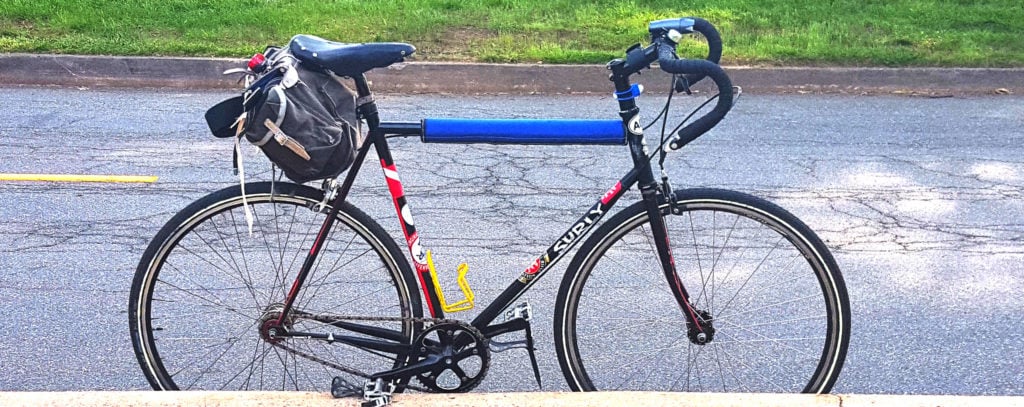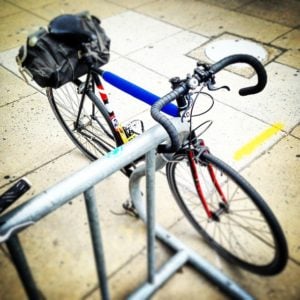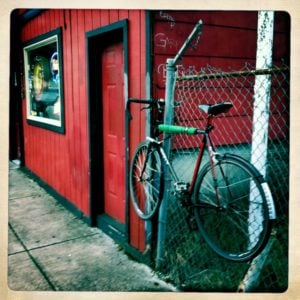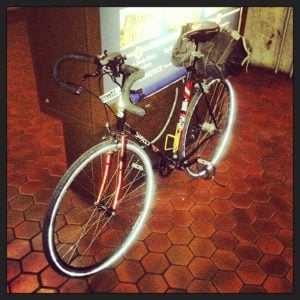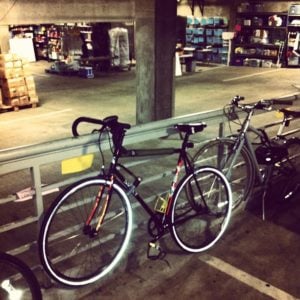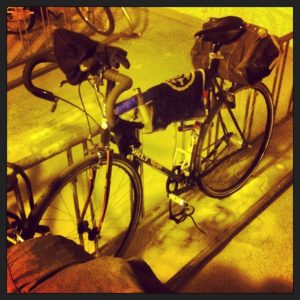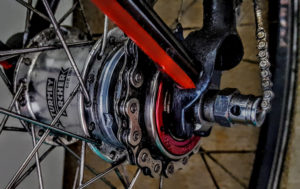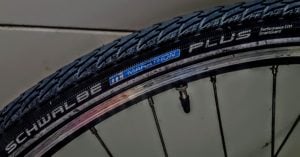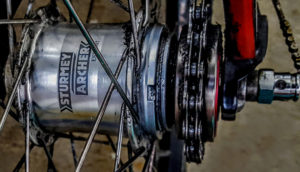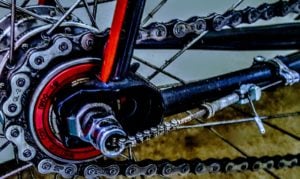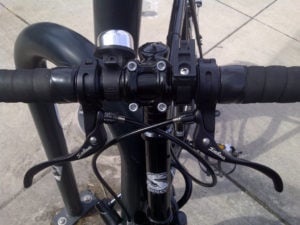Surly Bikes was founded in 1998 as a Minneapolis-based company with a focus on durable, practical, and versatile steel-frame bicycles. Surly is known for its no-nonsense approach to cycling, designing bikes that are highly customizable and suited for a variety of riding conditions, from commuting to off-road adventures. Steel frames, favored for their strength and longevity, are a hallmark of the brand, with the company’s ethos being rooted in the idea of creating bikes that can take a beating and keep rolling.
The Surly Steamroller is one of Surly’s flagship models, introduced in 1998, specifically designed for the fixed-gear and single-speed crowd. It was built with simplicity in mind, initially targeting urban cyclists looking for a reliable, easy-to-maintain ride for commuting or city cruising. The frame geometry reflects this, with relaxed angles that provide stability in traffic and on less-than-perfect road surfaces. The Steamroller's versatility allows it to accommodate relatively wide tires (compared to most road bikes), which further enhances its comfort and handling on different types of terrain.
While designed as a fixed-gear bike, the Steamroller is highly adaptable. Many riders, including Chris, have modified their Steamrollers to suit their needs—adding brakes, switching to freewheel, or even installing internal hub gears, like the Sturmey Archer S3X. This adaptability is a major selling point for those who want a durable platform that they can tweak and customize over time.
The Surly Steamroller, once a staple of Surly Bikes’ lineup, has been discontinued, marking the end of an era for fans of this iconic model. Introduced in 1998, the Steamroller gained a loyal following among urban cyclists and fixie enthusiasts for its durable steel frame and simplicity. As Chris mentioned, his own love affair with his 2010 Steamroller continues, despite the bike no longer being made.
Surly’s decision to stop producing the Steamroller leaves its legacy intact, and those who still ride it, like Chris, are keeping its spirit alive through personal modifications and years of reliable performance.
Chris's long-time love for the Surly Steamroller reflects its reputation for durability and customization. Starting as a single-speed, Chris modified his Steamroller with a Sturmey Archer S3X internal 3-speed hub to better handle the hills in his area. His journey with the bike showcases the Steamroller’s versatility, proving why it's remained popular with city riders for over two decades.
Surly’s Steamroller continues to hold a strong place in the world of urban cycling, with a dedicated following that appreciates its balance between minimalist design and maximum functionality.
Surly Steamroller Single Speed Steel Bike – Comprehensive Overview
Intended Use and Riding Scenarios
The Surly Steamroller is a single-speed/fixed-gear steel bike originally introduced in the late 1990s. It was designed to be a street-oriented fixie, optimized for urban environments rather than the velodrome. Over time, its reputation grew as a do-it-all platform for city riding, winter commuting, and light exploration. Key use cases include:
-
City Commuting: Its durable steel frame and predictable geometry make it an ideal urban commuter.
-
Fixed-Gear Street Riding: With horizontal dropouts and 120mm rear spacing, it handles fixed-gear use reliably.
-
Gravel and Light Trail Use: Unusual for a track-style bike, it has clearance for up to 38mm tires, making it capable of light gravel riding.
-
Track Racing (Occasional): It can be ridden on the track, but its geometry is more road-oriented than velodrome-specific.
-
Light Touring: Some owners have adapted it for minimalist touring with creative bag setups.
Geometry and Fit
The Steamroller blends track-bike simplicity with road-bike comfort. Key geometry and fit characteristics:
-
Frame Angles: 72° head tube angle across all sizes; seat tube angles vary by size from ~75° to 72°.
-
Bottom Bracket Drop: Approximately 66mm, providing a lower center of gravity and stable road handling.
-
Wheelbase: Long chainstays (~43cm) and relaxed angles give it a smooth, planted ride.
-
Tire Clearance: Can clear up to 700x38c tires without fenders; about 32c with fenders.
-
Fit: Sizing runs slightly large. Top tubes are relatively long, offering a stretched riding position unless you size down.
-
Versatility: Can accommodate drop bars or upright bars comfortably.
Pros and Cons
Pros:
-
Durability: Nearly indestructible 4130 chromoly steel frame.
-
Comfort: Smooth ride, especially with wider tires.
-
Versatility: Works as a fixie, single-speed, commuter, or light gravel bike.
-
Simplicity: Minimal parts mean minimal maintenance.
-
Stable Handling: Great for city traffic and rough roads.
-
Classic Styling: Timeless steel frame aesthetics.
Cons:
-
Weight: Heavier than rivals due to thick-gauge steel.
-
Limited Braze-Ons: No fender or rack mounts; only one bottle cage.
-
Not Track-Optimized: Lower bottom bracket and relaxed geo limit velodrome performance.
-
Component Quirks: Stock bars and cranks were polarizing in some years.
-
Discontinued: No longer in production as of 2023.
Comparisons to Other Bikes
-
All-City Big Block: Slightly more aggressive geometry, lighter, and more track-ready. Similar steel build quality.
-
State Bicycle Co. 4130: More affordable, but uses lower-end components and has less refined ride quality.
-
Fuji Feather/Bianchi Pista: More style-oriented, less durable or versatile than the Steamroller.
-
Mercier Kilo TT: Budget alternative with similar geometry but lower build quality.
Price and Availability
-
New: Discontinued as of 2023. Final MSRP was ~$800–$900 for complete bikes; ~$500–$600 for framesets.
-
Used Market: Common on Craigslist, eBay, Facebook groups. Expect ~$250–$350 for framesets, ~$400–$600 for completes.
-
Condition: Most used models are structurally sound, even after heavy use. Cosmetic wear common.
Model Evolution
-
1998 Launch: Introduced as a street-track frame.
-
2000s: Mostly sold as framesets; minimal design changes.
-
2010 Update: Slightly higher BB for track legality.
-
2011–2020: Spec changed to include upright bars (Open Bar). ED coating added for rust protection.
-
Colors: Rotated yearly — brown, grey, banana yellow, etc.
-
2023: Officially discontinued.
Legacy
The Steamroller built a cult following due to its blend of toughness, comfort, and simplicity. It became a benchmark for practical, steel fixed-gear bikes. While it’s no longer in production, its influence lives on in bikes like the All-City Big Block and in thousands of still-ridden frames across the globe.
The Steamroller is a true example of the "steel is real" ethos — reliable, understated, and built to ride hard for decades.
Full Details and Specification of the Surly Steamroller Single Speed Fixed Gear Pedal Bicycle
Frame Geometry and Tubing Details
The Surly Steamroller (2011) is a fixed-gear/singlespeed road frameset built from durable 4130 CroMoly steel. The main triangle is double-butted and TIG-welded for a balance of strength and ride quality. Surly designed it as a street fixie with geometry closer to a road bike than a track bike, making it more practical for urban riding (e.g. commuting, messengering, even light trail use) rather than velodrome racing. Key frame specs include:
-
Geometry: All sizes share a 72° head tube angle, while seat tube angles vary from about 75° on the smallest size to 72° on the largest, giving a slightly more relaxed seat angle as frame size increases. Bottom bracket drop is 66 mm (2.6") across all sizes, which is lower than a true track bike (providing stability on rough roads). Chainstay length is 420 mm on the smallest sizes (42–46cm) and 425 mm on larger sizes (50cm and up), allowing clearance for large tires while maintaining a reasonably short wheelbase. For example, the wheelbase ranges from ~989 mm on a 42cm frame up to ~1055 mm on a 62cm frame. (Surly offered frame sizes from ~42cm up to ~62cm; complete bikes were sold in a subset of those sizes, see Weight and Sizingbelow.)
-
Frame Material: Surly 4130 CroMoly steel, known for its springy yet tough ride feel. The frame is not the lightest, but is built for “excellent ride quality and durability” over the long haul. The fork is also CroMoly steel, using a lugged and brazed flat-crown design. This fork crown is drilled for a standard-reach caliper brake and clears up to 700×38mm tires.
Braze-ons and Dropouts: In keeping with its minimalist, no-nonsense design, the Steamroller has almost no braze-ons – no rack or fender mounts, and no rear brake cable stop (so adding a rear brake requires full-length housing). The only braze-on is a set of water bottle cage mounts on the seat tube (“’cause we’re not camels,” Surly quips). The rear dropouts are investment-cast Surly track-style dropouts spaced at 120 mm, suitable for track hubs or flip-flop hubs. The frame is track legal (no brake bridge or derailleur hanger to violate track rules) and has a high chainstay clearance to fit up to a 50-tooth chainring with proper chainline -
Tire Clearance: The Steamroller can accommodate up to ~38 mm tires (700c x 38) without fenders. This is unusually wide for a track-style frame, reflecting Surly’s intent to make an “all‑terrain fixed-gear” that handles rough pavement and even dirt paths. With clip-on fenders, you can fit tires around ~32 mm. Surly famously noted the Steamroller “will take tires up to about 38 mm” because “big tires make sense” for smoothing out bad roads. This generous clearance is a standout feature, letting riders use anything from narrow slicks to cyclocross knobbies or studded winter tires.
-
Additional Frame Specs: The seatpost diameter is 27.2 mm, with a 30.0 mm Surly stainless seatpost clamp included. It uses a standard 68 mm English-threaded bottom bracket shell and a 1-1/8" threadless headset interface. The frame weight is about 4.5 lb (2.0 kg) for a 56cm frame, and the uncut fork about 1.9 lb (0.85 kg)– not featherweight, but in line with Surly’s philosophy of sturdy steel over superlight materials.
Components of the 2011 Complete Bike
For 2011, Surly offered the Steamroller as a complete bike (in addition to a frameset). That year saw a notable change in spec: Surly moved away from the previous drop-bar or bullhorn setups and introduced their own upright “Open Bar” handlebar, paired with bigger tires and a lower gear, to emphasize urban utility over track racing. The 2011 complete Steamroller came with the following stock components (from the factory build).
-
Frame and Fork: Surly Steamroller frame, 4130 CroMoly steel with double-butted main triangle (as described above), and Surly Steamroller lugged steel fork (1⅛″ threadless steerer). The color for 2011 completes was a deep “Meth Teeths” Gray-Green finish (often looking charcoal/black in person; Surly later simply called it Gray Green).
-
Cockpit: Surly Open Bar handlebars – a 666 mm wide, zero-rise chromoly bar with a swept-back, ergonomic shape. This gives a more upright riding position for street comfort. The stem is a Kalloy AS-009 forged alloy stem (25.4 mm clamp to fit the Open Bar), and a Ritchey Logic Comp threadless headset secures the steering. The bike came with Velo Kraton rubber grips on the bars. This cockpit is a big departure from prior models’ drop bars or bullhorns, aligning with Surly’s intent to “ignore trends” and build the bike they wanted to ride– in this case, a practical upright bar for city use.
-
Drivetrain: Andel 1-piece crankset with forged arms and a 44‑tooth alloy chainring (3/32″ width). This is paired with a 19T Surly track cog (3/32″) on the rear hub, using a Surly lockring. The stock gearing thus is 44×19, a fairly low gear (~63 gear-inches with 32 mm tires) chosen “suitable to paths as well as roads”. (Notably, the previous year’s model ran 47×19, so 2011’s 44×19 makes pushing uphill or cruising easier at the expense of top speed.) The chain is a 3/32″ SRAM PC-830 singlespeed chain. Pedals were not included with the complete bike, as is common for Surly, leaving riders to choose their own platform or clip-in pedals.
-
Brakes: Unlike true track bikes, the Steamroller is drilled for brakes front and rear. The 2011 complete includes dual caliper brakes: Tektro R538 road calipers (standard reach 47–57 mm) in black finish. These are actuated by Tektro MT 2.1 brake levers– which are short 2-finger levers designed for flat/upright bars (since the Open Bar requires MTB-style levers, not drop-bar levers). Front and rear brakes are included in the spec (and were pre-installed on the complete bike), reflecting Surly’s acknowledgement that many riders would run the bike with at least a front brake for safe street riding. (The bike can still be run fixed without a rear brake if desired, but the frame has a rear brake bridgeto mount one, and Surly provided one out of the box.)
-
Wheelset: Surly’s own high-quality track hubs and sturdy rims. The hubs are Surly 32-hole sealed-bearing hubs, 100 mm front and 120 mm rear spacing. The rear is a flip-flop hub: fixed cog on one side (included) and threaded for a freewheel on the other (freewheel not included). Rims are Alex DA-22 alloy 700c rims (32h, double-wall) in black, laced with DT Swiss 14g stainless spokes and brass nipples. This wheel build favors durability over light weight, suitable for potholes and daily abuse. Users report these wheels (Alex DA22) hold up well even after years of hard use.
-
Tires: Continental Contact 700×32c tires, blackwall, were stock in 2011. (Some Surly literature calls them “Tour Ride” tires, which are a variant of Conti’s city tire line with puncture protection – essentially the bike was equipped with 32 mm all-purpose commuting tires from Continental.) These 32c tires take full advantage of the Steamroller’s generous clearance. By comparison, the 2010 model had 25 mm tires stock; moving to 32c in 2011 greatly improves comfort and flat resistance. Surly cheekily noted that calling it a Steamroller while only running skinny 23c tires wouldn’t make sense – “what can you run over on tiny tires?” The ability to run up to 35–38 mm rubber (even studded winter tires) is a defining trait of this bike.
-
Seat and Post: WTB SST saddle with Cromoly rails, in black vinyl cover. This is a mid-range, ergonomic saddle suitable for city riding. The seatpost is a 27.2 mm Kalloy aluminum post (model SP-248D) in black, held by a Surly stainless 30.0 mm clamp (also black). The saddle and post provide a decent out-of-the-box setup, though many riders eventually swap to their preferred saddle (for example, some put on Brooks leather saddles for comfort and style) (All component specifications above are per Surly’s 2011 catalog and retailer listings. Small variations might occur in production, but Surly emphasized durable, no-nonsense parts – e.g. the hubs, cog, and handlebar are Surly’s own, while other parts come from trusted third-party suppliers like WTB, Continental, Tektro, etc.)
Weight and Sizing Information
Surly did not advertise an exact complete-bike weight for the 2011 Steamroller, but it’s generally regarded as a sturdy “tank” of a bike rather than a lightweight. Riders who have weighed their bikes report around 22 lbs (10 kg) for a mid-size build with brakes and a Brooks saddle. Given the stock spec (steel frame, wide tires, burly wheels), a weight in the low 20-lb range is expected. For reference, the frame alone weighs ~4.5 lbs (2.0 kg) in size 56cm and the fork ~1.9 lbs (0.85 kg) uncut. With components, the complete bike likely comes in around ~22–23 lbs (without pedals) in a medium size. This is a bit heavier than an aluminum track bike, but in line with Surly’s steel commuter ethos. Owners often note the bike feels smooth and fast despite the weight, thanks to the lively steel and momentum of the wheelset.
Size Range: In 2011 the Steamroller complete was offered in approximately five sizes: about 49, 53, 56, 59, and 62 cm (these are the nominal sizes often quoted by retailers). Surly’s geometry chart, however, lists frame dimensions in terms of seat tube length (center-to-top). The frameset was produced in sizes from 42 cm up to 62 cm, including some intermediate sizes. Essentially, Surly made nine frame sizes, but not all were sold as completes every year. The approximate matching is: a “49cm” complete corresponds to a ~50 cm seat tube (c-t), “53cm” to ~54 cm, “56cm” to 56 cm, “59cm” to ~60 cm, and “62cm” to 62 cm. This gave a decent fit range from smaller riders around 5’5″ up to tall riders over 6’2″. Stand-over heights range from ~29″ on the smallest to ~34″ on the largest.
Geometry Highlights: The Steamroller’s geometry is optimized for quick but stable handling on city streets:
-
Angles: 72° head tube angle (all sizes); seat tube angle ranging from 75° on the smallest frames down to 72° on the largest. This means smaller sizes are a bit more upright over the pedals, while larger sizes are slacker for a roomier cockpit. A 72° head angle is fairly relaxed for a track-style bike (true track frames often 73–74°), again favoring stability and control on rough pavement or dirt.
-
Bottom Bracket & Standover: The bottom bracket (BB) drop is 66 mm, which puts the BB lower than pure track bikes (typically ~55 mm drop). The lower BB gives better cornering stability and a lower center of gravity. The trade-off is slightly reduced pedal clearance when cornering, but for road use this is generally beneficial. Standover height (with 700×30 tires) on a 56 cm frame is about 32″ (810 mm), and around 30″ (750 mm) on a 46 cm frame (standover is measured mid-top-tube to ground).
-
Top Tube and Reach: The effective top tube lengths are moderate – e.g. ~570 mm on the 56 cm size, 580 mm on 58 cm, 522 mm on 42 cm. This, combined with the angles, results in a riding position akin to a road bike from the early 2000s. It’s long enough for efficiency but not as stretched-out as a track sprint frame. The head tubes are relatively short (e.g. 121 mm on 56 cm, 160 mm on 60 cm), which originally would suit a low, aggressive bar position. However, in the 2011 build with upright bars, many riders end up with spacers or an up-angled stem to raise the bars (given the head tube wasn’t lengthened for the new bar). This is one critique some had (see Reviews below): the frame’s geometry was designed for drops, so the 2011 complete had an intentionally high handlebar on a short head tube, creating an odd look but a comfy ride.
Overall, the sizing and geometry make the Steamroller very accessible and versatile. You can set it up aggressive with drop bars (many do, by swapping out the Open Bar) or run it upright. The long wheelbase and fat tires give confidence on rough roads and even gravel. Surly described it as “right at home” on bad roads and even dirt tracks. It’s not twitchy like a track bike; instead it’s often praised for feeling stable, smooth, and forgiving without being sluggish.
Variants and Year-to-Year Differences
The Steamroller has been a Surly staple since the late 1990s, and while the core frame design remained largely unchanged, Surly updated colors and spec over the years. Here we’ll highlight the 2011 model’s variants and how it compares to surrounding years:
-
Frameset vs Complete: Surly sold the Steamroller as a bare frameset (frame + fork) and as a factory-built complete bike. The frameset in 2011 included the frame, fork, and seatpost clamp, but no headset or other parts. It was identical to the complete bike’s frame. Importantly, the frameset gave riders the freedom to build it as a pure track bike, singlespeed road bike, or any custom configuration. The complete bike (2011) came ready-to-ride with the spec listed above. Aside from components, the only difference was possibly color options: Surly’s catalog shows “Meth Teeths Gray-Green” as the 2011 color for both frame and complete. In prior years, Surly offered multiple colors; for example, 2010 was available in “Creamroller” (cream white) or “Blaque” (gloss black). By 2011, they consolidated to the one gray-green scheme (Surly jokes in the 2012 catalog calling it “Gray Green, formerly known as Meth Teeths or Superblack”). The frameset and complete shared that same paint in 2011.
-
2010 vs 2011 Spec Changes: The 2010 Steamroller complete had a very different setup: it shipped with bullhorn-style alloy handlebars (no drop grooves) and Tektro RL570 cross brake levers on the flat portion. Its gear was 47×19 (47T chainring) and it rolled on Maxxis Detonator 700×25c tires. Essentially, it was configured more as a fast urban/track bike in 2010 – narrow tires, higher gear, low bullhorn position. For 2011, Surly “changed the component spec” dramatically: they outfitted it with the Open Bar upright handlebars, a smaller 44T chainring, and 32c tires, plus front and rear brakes. This effectively turned the Steamroller into a more all-round street commuter. Surly’s own description says they gave it “big shoes” (big tires) and a “wide upright-ish bar” to make an “all terrain fixed-gear” inspired by the old days when racers took fixies on dirt tracks. Not everyone loved the change – some traditionalists thought the 2011 spec looked odd or “lame” at first glance, since the frame’s short track-style head tube wasn’t designed for high bars. One BikeForums commenter felt “the Steamroller frame is simply mismatched with the 2011 spec. A more appropriate frame would have a longer head tube” for such upright bars. Surly’s rebuttal would be that you can always swap bars; they provided a solid platform and durable parts, letting the rider personalize it.
-
2012–2013: The 2012 model year was essentially the same as 2011. The gray-green color continued, and the Open Bar setup with 44×19 gearing remained. Around 2013, Surly changed the color to a bold “Shag Carpet Orange” (one of the many memorable paint names in Steamroller history). The spec stayed similar – still an upright bar complete. Surly’s Legacy library lists a variety of Steamroller colors over the years, including Banana Candy Yellow, Metallic Lilac, Frost Blue, Monkey Butt Red, Zinc, etc., showing that nearly every year or two a new color was introduced. Aside from paint and minor component tweaks, the frame geometry and basic build concept stayed consistent from 2011 onward: the Steamroller was kept in the line as that single-speed steel bike for road and city use.
-
Later 2010s: By the mid-2010s, the Steamroller complete had earned a reputation as a reliable street fixie. Reviews in 2017–2018 still describe it as coming with the surprisingly wide Open Bar and 700×32 tires. Surly sometimes shipped it with different tire models or saddles as supply dictated, but the ethos remained. One notable change: in later years Surly began selling the Steamroller mostly as a frameset, and complete bikes became less common or limited in availability. For example, by 2018 you could find a complete, but by 2020–2021 Surly’s focus was more on frameset sales (many riders building custom).
-
Discontinuation: In September 2023, Surly announced it was discontinuing the Steamroller after a 25-year run. This meant 2022 was effectively the last model year (often coming in a final color like a dark metallic, e.g., “Ministry Gray” or similar). The decision marked the end of an era: the Steamroller had been one of Surly’s earliest models (first introduced in 1998). Its core design stayed so constant that a frameset from 2005 or 2015 or 2020 are all very much alike, and parts are interchangeable. This consistency is a testament to the Steamroller’s concept – it didn’t need major changes. Surly themselves said in a BikeRadar review that the platform “has remained largely unchanged for the past zillion years” (an exaggeration, but only slight!). In summary, the 2011 Steamrollerrepresents a midpoint in the model’s timeline where Surly pivoted the build toward utilitarian street riding, a configuration that basically carried through until the end of production.
User Reviews and Performance Insights
The Surly Steamroller has a devoted fan base, and many riders have shared their firsthand experiences. Overall, the bike is praised for its ruggedness, smooth ride, and versatility, while criticisms usually focus on weight or certain omissions (like lack of fender mounts or true track geometry). Below is a compilation of performance insights from owners and professional reviewers:
-
Ride Quality – “Smooth and Durable”: A common theme is that the Steamroller rides very smoothly for a stiff steel bike. Riders credit the big tires and steel frame for soaking up bumps. One owner in St. Paul, MN described his Steamroller as a “tank” that “rides very smooth”, noting “it may be steel, but it feels smooth and fast to me”. Numerous anecdotes speak to its durability: “My girlfriend’s Steamroller fell off our car… and not more than a scratch on the paint,” said one user, who also noted she played bike polo on it for two years and the frame was “solid as a rock with no damage”. These stories underline the Steamroller’s bombproof construction – it’s a bike that can take abuse and “will last you forever” in the words of another rider. The combination of a simple drivetrain and sturdy steel means there’s not much to go wrong, even if you crash or hit potholes.
-
Handling and Use Case: Riders generally find the handling quick but not twitchy. It’s often called confidence-inspiring in messy urban settings. The relatively low BB and not-too-steep angles make it less nervous than track bikes. As one Redditor summarized, the Steamroller is “versatile (could be used as a winter bike because of the big tire clearance… up to 42c), [and] comfortable”. Many use it for daily commuting, errands, or as a do-it-all city bike. Its ability to run as a fixed gear or single-speed freewheel adds to versatility (just flip the rear wheel). Some even take it to gravel paths or cyclocross races – a bike shop in San Francisco noted the Steamroller “plays well in the single speed class during ’cross season” when fitted with 32c cyclocross tires. What it’s not commonly used for is velodrome racing or freestyle tricks. Fixed-gear racers find the bottom bracket too low for aggressive track banking, and street trick riders find the fork clearance too tight for things like bar spins (Surly themselves humorously warned “What won’t it do? Bar spins.”).
-
Weight and Efficiency: Nearly all reviews mention the Steamroller is not light – often using terms like “tank” or “beast”. At ~22–23 lbs, it’s heavier than boutique track frames, but riders say it still accelerates and holds speed well. A cyclist.co.uk review noted the bike’s “moderate weight and quality wheels” help it roll with momentum. Owners report that once you get it moving, it “holds inertia well” and feels stable. Climbing hills on a fixed gear can be tough, but the 44×19 gearing mitigates that a bit. No one buys a Steamroller to be a featherweight racer; instead they appreciate that it’s “reliable, smooth, solid” (all words that came up in user reviews). In trade for a few extra pounds, you get a bike that doesn’t flex much when you sprint (the frame is stout) and doesn’t mind rough treatment.
-
Comfort and Fit: With the 2011+ upright bar configuration, many riders find the bike immediately comfortable for casual riding. The wide 32 mm tires at moderate pressure make for a cushy ride on bad pavement. One professional review in Cyclist magazine described the Steamroller as “a comfortable steel streetfighter with a unique cockpit.” That “unique cockpit” refers to the swept-back Surly Open Bar – unusual on a stock fixie, but giving a relaxed position. Some riders did swap to drop bars if they wanted a more traditional fixed-gear feel or a lower aero position. Either way, the frame’s handling works with either; as one owner put it, the geometry is “perfect… not too aggressive, not too slack”. The main comfort limitation noted is the lack of braze-ons for full fenders, which a few users pointed out. For example, one commenter complained that making a winter/commuter bike with huge tire clearance but “without fender mounts is pretty dumb”– you can put fenders using clamps/P-clips, but it’s not as elegant. Another user cynically replied that Surly leaves off fender mounts “to encourage commuters to go with the Cross-Check” (Surly’s geared commuter model). Nonetheless, plenty of Steamroller riders commute year-round, fender or not (some use clip-on fenders or just get a little wet).
-
“Track” vs Street: The Steamroller often gets compared to true track bikes (e.g., the famous Bianchi Pista or similar). Enthusiasts point out it’s not a pure track geometry – and that’s by design. The bottom bracket is lower, which is great for street stability but means pedal strikes if you tried to race it on banked velodromes or do fixed-gear freestyle tricks. One fixed-gear rider summarized Pros and Cons: Pros: strong frame, versatile, comfortable, inexpensive; Cons: “Relatively heavy” and “no real track geometry (BB is too low). It doesn’t make a good track bike if you’re intending to take it to a velodrome.”. In other words, the Steamroller occupies a niche as an all-rounder: tougher and more utilitarian than a boutique track frame, but more performance-oriented than a pure cruiser. Many call it an ideal urban fixed-gear. BikeRadar’s tester in 2017 was initially unsure about the lack of brake cable guides (the fixie purity can be inconvenient), saying “I really wouldn’t mind having two vestigial cable stops on the top tube if I did want to run brakes”. But ultimately reviewers and users alike appreciate that the Steamroller is simple and fun. It’s the kind of bike that, because it’s not precious or finicky, begs to be ridden hard: locked up outside without worry, ridden through potholes, jumped off curbs, etc., all while delivering that direct connected feel of a fixed gear.
In summary, the Steamroller’s reputation is that of a workhorse with a soul. It’s often recommended as a first fixed-gear bike for someone who wants a reliable setup, or as a lifelong bike that can be modified endlessly. As one long-term owner wrote after 7 years: “these bikes are not just transportation tools but cherished companions… a durable friend”, highlighting how the Steamroller becomes a personal artifact of one’s cycling life. The ride experience is defined by the rider: some keep it brakeless and mash through the city, others add an internal 3-speed hub or brakes and turn it into a chill commuter. The consensus is that it’s enjoyable to rideand tough to break – a combination that for many justifies its cult following.
Current Availability and Market Value
As of today, the 2011 Surly Steamroller (and all model years) is no longer in production – Surly has discontinued the Steamroller frameset as of late 2023. Therefore, the only way to get one is on the secondhand market. The good news for fans is that Steamrollers were made for a long time and in decent quantities, so used frames and bikes do pop up regularly on sites like Craigslist, eBay, and Pinkbike. Here are some insights into its current availability and value:
-
Used Market Pricing: A Steamroller holds its value fairly well for a steel single-speed, but it’s not outrageously expensive. Original MSRP for a complete bike was around $800 USD in 2011 (for comparison, the frameset alone was about $420 retail around that time). On the used market today, you’ll commonly see framesets for $200–$300 and complete bikes for roughly $400–$600, depending on condition and upgrades. For example, a recent listing for a barely-used 62 cm Steamroller complete was asking $450. Another seller had a frameset only (62 cm, with some extras) for about $300 (and it attracted many watchers). Prices can vary by region – in bike-centric cities or fixed-gear communities, demand is higher. Bicycle Blue Book estimates a private-party value around $210 for a 2011 complete in good condition, which is arguably a low estimate; in practice, enthusiasts often pay a bit more due to the model’s cult status.
-
Collectibility: The Steamroller is somewhat of a cult classic, but it’s not a rare exotic collectible – it’s more of a “working man’s classic.” Because the frame changed so little over the years, later models don’t command a premium over earlier ones; condition and color desirability matter more. That said, now that it’s discontinued, some riders are snapping up frames for nostalgia or future use. Particular limited colors (Surly had fun ones like Metallic Lilac or Banana Yellow in certain years) might fetch a bit more from someone seeking that color. Overall, it’s the kind of bike people hold onto and run into the ground, rather than a showpiece that sits in a collection. As the Surly blog noted, the Steamroller’s legacy is about being “built to last and designed to be shaped by their riders” – many of these bikes have decades of stories embedded. So while you won’t likely sell a used Steamroller for thousands, you will find a small but eager marketof riders looking for a solid steel fixie they can trust.
-
Availability: Since new Steamrollers aren’t on bike shop floors anymore, your best bet is the secondhand channels. Check local bike swaps, online forums (the fixed-gear community often circulates these), and classifieds. As of 2024, some shops might still have new-old-stock frames in inventory – for instance, a dealer that had unsold Steamroller frames might be selling them at a discount. Surly’s parent company (QBP) likely cleared out remaining stock to shops after announcing the discontinuation. So it could be worth calling around if you want an unridden frame. But realistically, most people will find one used. Luckily, the Steamroller’s reputation for longevity means even a well-used frame can be a good find if not rusted out or crashed. The simple design and lack of complex parts (no derailleurs, etc.) mean that a secondhand Steamroller can often be revived cheaply if needed (perhaps just new tires and a chain).
-
Resale Insights: If you own a Steamroller and are considering selling, note that its value might slightly increase now that it’s discontinued, but it’s still a niche bike. You’re selling to a specific audience (likely someone who specifically wants a Steamroller for what it is). Many owners sentimentally hold onto them – it’s not uncommon to see 15-year-old Steamrollers still in service. However, if in great shape, you can market it as a legendary model with Surly’s cachet. Internationally, Surly bikes sometimes cost more (due to import costs); for instance, in some countries a used Steamroller might be harder to find and thus priced higher.
In conclusion, the 2011 Surly Steamroller remains a sought-after bike in the fixed-gear and urban cycling scene, not for rarity or high-end value, but for its reputation and character. It’s a bike people buy to ride, not to flip for profit. Even in 2025, you’ll see Steamrollers locked up outside hip cafes, or shredding through city traffic, or converted into quirky projects – a testament to the timeless appeal of this simple steel machine. As Surly said in their 2011 catalog, “This is one of our favorites, and it’s been around since the early days of Surly”. That statement holds true: the Steamroller earned its place in cycling history as an unpretentious, bulletproof bike that riders form a real attachment to. If you find one today (and you likely can with a bit of looking), it’s still absolutely worth throwing a leg over and experiencing that magic formula of steel frame + fixed gear + big tiresfor yourself. The white “Surly” decal and model name contrast the 2011 bike’s dark Gray-Green paint. Note: no rear brake cable stops on the top tube – brake housing runs uninterrupted to the rear caliper.
Surly Stopped Making the Steamroller
Surly's decision to discontinue the Steamroller has transformed it from a common sight to a rare and special find among cycling enthusiasts. Introduced in 1998, the Steamroller quickly became a cornerstone of urban cycling culture, celebrated for its simple yet robust design. Its steel frame, known for durability and comfort, catered to riders seeking a no-nonsense, adaptable bike for city commuting and casual riding.
For over two decades, the Steamroller epitomized the ethos of Surly Bikes: practicality, resilience, and versatility. Its geometry was perfectly suited for urban environments, striking a balance between the nimbleness needed for navigating traffic and the stability required for varied road conditions. The frame's ability to accommodate wider tires also added to its appeal, allowing riders to tackle less-than-perfect streets with ease.
In September 2023, reports emerged that Surly informed dealers of no future production plans for the Steamroller, marking the end of its production run.
This decision has left a noticeable gap in the market for riders who appreciate minimalist yet highly functional bikes. For those who still ride them, like myself, these bikes are not just transportation tools but cherished companions. Each modification and every mile ridden adds to their character, making them more than just machines—they become personal artifacts of cycling culture.
As the Steamroller becomes a rarer sight on the streets, its legacy grows. It symbolizes an era when bikes were built to last and designed to be shaped by their riders. For me and countless others, the Steamroller isn't just a bike; it's a lifestyle statement, a durable friend, and now, a piece of cycling history.
Author’s Biking Background
Chris Abraham is a long-time fixed-gear and single-speed rider, with a history of several bikes before his Surly. His first was a 2000 Bianchi Pista (ridden with a freewheel and front brake) which was stolen, as was a custom-built 2007 SOMA Delancey track bike loaded with high-end “Gucci” components – both fell victim to rampant bike theft in Berlin. He then switched to an aluminum Specialized Langster “Gangster” single-speed in Berlin. In harsh winter conditions, the Langster’s freewheel would freeze up, forcing Chris to pour hot water over it to get moving again. Frustrated by the silent freewheel locking up in the cold, he decided to embrace clicky, loud freewheels for reliability – ultimately installing a buzzing red White Industries Eno freewheel on his next bike, the Surly. After leaving Berlin (he even passed that Langster on to a friend’s son when moving away), Chris was ready for a new ride that could handle city life without constant tinkering or theft anxiety.
Why the 2010 Surly Steamroller?
In 2010, Chris chose the Surly Steamroller as his new city bike. He ordered it as a complete bike directly from Surly, deliberately avoiding the costly, piecemeal upgrade path (“the Gucci gulch”) that he’d taken with his previous custom build. The Steamroller appealed to him as a durable, no-nonsense steel frame bike that could “take a beating and keep rolling,” aligning with Surly’s reputation for practical, bombproof urban bikes. In other words, it was a simple, reliable canvas that he could gradually tweak to his liking without the flashiness that attracted thieves. This unpretentious workhorse was the perfect platform for a long-term daily rider, and thus began his “love affair” with the 2010 Surly Steamroller.
Modifications and Upgrades Over the Years
Over seven years of ownership, Chris made numerous modifications to personalize and improve the Steamroller’s setup:
-
Handlebars & Controls: The bike came with cloth-wrapped drop bars and stock brakes, but Chris soon swapped in better stoppers – Shimano 105 brake calipers with short, two-finger Salsa cross levers – for more confident braking. Later, he upgraded the cockpit by installing Nitto bullhorn handlebars wrapped in bright orange Cinelli bar tape, giving the bike extra style and a comfortable, forward-leaning riding position.
-
Drivetrain & Gearing: Drawing from his Berlin experience, Chris fitted a loud White Industries Eno freewheel on the Surly for its reliable “buzzbomb-sounding” clicks. This ensured no more surprise freeze-ups and also served as an auditory deterrent to complacent pedestrians. Eventually, he went a step further and converted the single-speed into a 3-speed (details in a later section) by installing a Sturmey-Archer S3X internal hub, to better tackle hills while still retaining the fixie simplicity.
-
Saddle: Comfort is key for a bike ridden daily, so Chris replaced the Steamroller’s stock saddle with a classic Brooks B17 leather saddle. This Brooks saddle, known for molding to the rider over time, became a staple on his bike, adding vintage style and long-ride comfort for years.
-
Pedals: For a solid foot connection, he initially used wide cage MTB platform pedals with toe clips and straps. In time, he ditched the toe clips and upgraded to a pair of bright orange Crank Brothers Stamp 1 flat pedals, preferring their large platform and grip for city riding. The orange pedals not only improved function but also matched his handlebar tape – a fun personal touch.
-
Wheels & Tires: Impressively, the Steamroller’s stock Alex DA22 alloy rims have held up for the entire seven years. Chris equipped them with Schwalbe Marathon Plus 700×28c tires, renowned for toughness. He’s only on his second set of these tires in seven years, and the Marathon Plus have lived up to their “flat-less” reputation – he hasn’t had a single flat tire in all that time. Though heavier than skinny racing tires, their puncture-proof performance and reflective sidewalls (for visibility) make them ideal for worry-free urban commuting. (He’s even thought about trying a wider 32mm size if it fits, for extra cushiness.)
Personal Touches and Accessories
Chris didn’t just stop at functional upgrades; he added many personal touches to make the bike uniquely his and better suited for city life:
-
Reflective Tape for Safety: After one nerve-racking late-night ride home on a Northern Virginia trail without his lights, Chris added lots of red 3M reflective tape to the Steamroller’s black frame. Now, even if his lights fail or batteries die, any car headlights will light up the bike’s frame, dramatically improving his visibility in the dark. This simple hack speaks to his practical, safety-conscious approach.
-
Top Tube Pad: For a bit of style and frame protection, he fitted a handmade Black Star top tube pad. Not only does it cushion the top tube (nice for shouldering the bike or protecting the paint), it’s also reversible with two colors – one side bright green and the other purple. Early photos showed the pad in green, but he later flipped it to purple; he enjoys swapping the color occasionally for fun. It’s a unique, quirky accessory that gives the bike character.
-
Canvas Tail Bag: One of Chris’s favorite additions is a large canvas saddle bag on the rear of the bike. This bag was gifted by a friend (an even more avid cyclist) and attaches to the Brooks saddle via a wooden dowel and hose clamps on top, plus a buckled leather strap around the seat post. The bag is quite cavernous – it features a main compartment and side pockets secured with leather straps and brass studs. He keeps a battery-powered red tail light mounted on it, and cleverly tucks his heavy U-lock into the straps when riding so it’s always handy. An acquaintance identified the bag as a Carradice (made in Nelson, England), known for being virtually bombproof; in fact, it was well-used when Chris received it, and it will probably “outlive your bike” as they told him. This sturdy vintage bag not only adds practical carrying capacity for errands and commuting gear, but also lends the Steamroller a classic, utilitarian look.
-
“Stealth” Anti-Theft Setup: Chris appreciates that the Steamroller isn’t an overly flashy, high-end looking bike – it flies under the radar. The wheels are attached with nuts (no quick-release skewers), which deters casual wheel theft since a thief would need tools and time. Between that and always locking the frame (and often the front wheel) with a U-lock, he’s made the bike inconvenient to steal. In the greater DC area, many expensive bikes are poorly locked, so he jokes that his unassuming “gray man sleeper” bike is unlikely to be targeted when parked beside showier $3,000 bikes that are barely secured. This pragmatic approach to security is another personal aspect of how he outfits and uses the Steamroller in the city.
Riding Style and Use Cases
Chris uses his Surly Steamroller as a daily rider and city workhorse. Primarily, it’s his urban commuting bike around the Washington, D.C. and Arlington, VA areas. He’s ridden it on city streets, in traffic, and through varied terrain typical of the area. The single-speed setup served him well on the relatively flat route between D.C. and Arlington (Ballston), getting him around town efficiently. However, when he later moved to a neighborhood at the top of a short but steep hill (the Columbia Pike area by the Pentagon), he found the incline “kicked his butt” on one gear. This daily reality – needing to tackle a tough hill on his commute – is what pushed him to modify the bike with more gears (without giving up the simplicity he loves, as discussed below).
Beyond commuting, he isn’t afraid to take the Steamroller on longer rides and trails. He recounts riding home late at night on trails (for example, a long ride from D.C. back into NoVa) – experiences that prompted him to improve the bike’s lighting and reflectivity. The bike handles these multi-use paths and rough city roads with ease, thanks to its stable geometry and tough tires. Chris rides year-round, even in less-than-ideal conditions. From subzero winters in Berlin to rainy nights in Virginia, the Steamroller has been by his side, and he equips it accordingly (warm memories of thawing a frozen freewheel with hot tea come to mind from his earlier bikes). He’s not racing this bike or doing track tricks; instead, his riding style is about practical transportation, fitness, and enjoyment. The Steamroller is set up to be reliable and comfortable for everyday use – meaning Chris can get to his destination with minimal fuss (and minimal sweat, thanks to that gearing upgrade) and maximum enjoyment of the ride.
Performance and Reliability
One of the strongest themes in Chris’s story is how reliable and durable his Surly Steamroller has proven to be. After seven years of heavy use, the bike still performs admirably, a testament to Surly’s steel frame construction and to Chris’s smart component choices. Some highlights of its performance and longevity include:
-
Rock-Solid Durability: The Steamroller’s steel frame and core components have held up to years of city abuse – potholes, curbs, and all. Remarkably, Chris hasn’t even had to replace the wheels or many major parts. The original Alex rims are still rolling true after 7+ years. The bike has needed very little beyond routine maintenance and the planned upgrades; it’s a ride-it-everyday kind of bike that doesn’t constantly break or need adjustment.
-
No Flat Tires: Thanks to the puncture-resistant Marathon Plus tires, flats are a thing of the past for Chris. He reports that he has never experienced a flat tire in all seven years of riding the Steamroller. This is an incredible reliability win – he can head out the door each day not worrying about stray glass or thorns slowing him down. The trade-off for these tires is extra weight, but for Chris the zero flats and even the reflective safety stripe are well worth it.
-
Internal Hub Reliability: After the initial hiccups and learning curve (detailed below), the Sturmey-Archer 3-speed hub has been “tight, reliable and very effective,” in his words. Once he adjusted his shifting technique, the hub has held up under his weight and power without issue. It’s a sealed system, so it’s largely immune to weather and dirt – perfect for a commuter that sees all conditions. Chris describes the S3X hub as “100% durable and bulletproof once you get the gears changed”, which gives him confidence in its long-term performance.
-
Overall Ride Quality: The Steamroller isn’t the lightest or fastest bike by racing standards, but for Chris’s purposes it performs wonderfully. The ride is smooth and stable, aided by the wider tires and comfortable cockpit. He notes that adding the 3-speed made a huge difference in how fresh he feels upon arrival: it “allows me to arrive at my destinations a little less sweaty and beat up” – truly a “game-changer” for his commute. While it still isn’t geared like a road bike (the top gear is only as high as his original single-speed ratio, and the lowest gear is not extremely low), the bike now handles moderate hills with ease and has greatly expanded its versatility. In sum, the Steamroller has proven to be a trustily solid, low-maintenance companion – the kind of bike that just keeps on going year after year.
Converting to an Internal 3-Speed Hub
One of the most significant changes Chris made was converting his beloved Steamroller from a pure single-speed/fixie into a 3-speed hub-equipped bike – essentially turning it into a sort of modern “Dutch bike” while keeping its fixed-gear spirit. Here’s how and why he did it, and his reflections on the conversion:
-
Why Add Gears?: After moving back to the U.S. from flat-as-a-pancake Berlin, Chris found himself in Arlington, Virginia, facing new terrain. His ride between DC and Ballston was manageable on one gear, but after relocating to a hillier area near Columbia Pike, one particularly steep short hill started to “kick his butt” on the fixie. Rather than give up his Steamroller or suffer through walking uphill every day, he began researching internal multi-speed hubs that would work on a track bike frame. He wanted an elegant solution that preserved the bike’s clean single-speed look and feel.
-
Choosing the Hub: For fixed-gear/single-speed aficionados, the Sturmey-Archer S3X hub was the leading (if not only) choice at the time. It’s a 3-speed internal gear hub designed for fixed-gear bikes (meaning it allows three different gear ratios but still doesn’t freewheel). All roads led Chris to the Sturmey Archer S3X, and he purchased the hub in silver. He had it professionally installed by his local bike shop, Papillon Cycles in Arlington. The shop handled the wheel build and installation, including mounting the shift lever on the right end of his handlebar.
-
Initial Learning Curve: Right after the conversion, Chris actually managed to break the hub almost immediately. The issue wasn’t a defect of the product but rather the way he was shifting. The bike shop rebuilt the hub under warranty and gave him a crucial tip: unlike derailleur gears, which shift while pedaling, an internal gear hub requires you to momentarily stop pedaling (coast) to shift. In other words, you have to ease off power and let the hub do its thing before pedaling again. Chris took this lesson to heart and adjusted his technique.
-
Life as a 3-Speed: Once he mastered the shifting method, the S3X hub transformed his ride. Since then, it’s been “blue skies” – he absolutely loves having the extra gears. The Steamroller effectively became a 3-speed city bike that could smooth out hills while still feeling like the same trusty fixie. The internal hub is now running trouble-free; no more slipped shifts or loose cables. Early on, he did have a minor issue with his heel knocking the hub’s shift chain and loosening it, but that was resolved with adjustment. Now everything stays tight and aligned.
Chris notes that the gear range is modest: the highest gear is only as high as his old single-speed ratio, and the lowest isn’t as low as a true granny gear on a multi-speed bike. So while it’s not meant for conquering very steep climbs or replacing a full mountain bike drivetrain, those three gears make a noticeable difference. The middle gear is his old direct-drive, the high gear helps on downhills or fast flats, and the low gear gives just enough help on inclines to save his knees and energy. “This is no mountain goat setup,” he explains, “but it surely smooths out the road”, letting him arrive much less exhausted. In fact, the added low gear has been a game-changer for his commute and errands. He can tackle the previously dreaded hills with far more ease – though he humorously admits that being “very heavy and out of shape” at the moment means even three speeds won’t get him up the absolutely steepest sections without a challenge. Still, for typical urban terrain, the 3-speed conversion struck the perfect balance between simplicity and functionality.
-
Shifter Setup: To keep the look clean, Chris had the shifter mounted at the end of his handlebar (when he still had drop bars, it was a bar-end shifter on the right side). This placement felt natural and out of the way. Even after switching to bullhorn bars, the shifting mechanism remains unobtrusive. The conversion didn’t clutter the bike – it still looks minimalist – which was important to him. All the work was done by his trusted bike shop, and he plans to go back to them for any future upgrades like the front dyno hub. In summary, converting to an internal 3-speed hub was a highly positive move: it preserved everything he loves about the Steamroller (the straightforward, robust single-speed feel) while addressing its only limitation (climbing ability). Chris effectively future-proofed his bike for the hills of the next seven years of riding.
Tone and Reflections
The tone of Chris Abraham’s article is enthusiastic, personal, and slightly nostalgic. He writes about his bike with genuine affection – even personifying it as a “she” and referring to the essay itself as his “love letter to my 2010 Surly Steamroller 3-speed city bike”. This choice of words makes it clear how much the bike means to him. The nostalgia comes through as he reminisces about past bikes and seven years of memories with the Steamroller. For example, he humorously notes he’s been riding fixies “since before some baby hipsters were born,” establishing his long history in the scene with a wink. The overall vibe is practical yet passionate. Chris is practical in that he dives into detailed discussions of components, reliability, and hacks to improve his ride – the piece reads at times like advice from a seasoned bike commuter. Yet he’s also enthusiastic and humorous, maintaining a light, engaging tone. He celebrates the bike’s quirks and strengths with the delight of an owner still smitten after years. In short, the article feels both nostalgic (looking back fondly on a 7-year journey) and enthusiastic (almost like a proud parent bragging about a child’s accomplishments), all delivered in a friendly, down-to-earth voice. Chris’s love affair with the Surly Steamroller is conveyed with a mix of sentiment and straight-shooting practicality, making the reader both appreciate the bike and perhaps learn a thing or two about creating their own perfect city ride.
My Ultimate Gucci Pimped 2010 Surly Steamroller Wish List (Big Boy Edition)
This is the dream build for my beloved 2010 black Surly Steamroller — my fantasy setup, combining bulletproof utility with unapologetic flair. I'm a big guy — 6'3" and 300+ pounds — so everything here is specced to handle power, weight, and street abuse. No delicate boutique parts. No flexy noodle nonsense. This build is all gusto, all guts, all go.
🎨 The Frame – Keeping It Stealth, Coated in Swagger
-
Fresh Cerakote or powder coat in deep matte charcoal with gloss black decals (or ghosted logos)
-
Discrete black 3M reflective tape along seat stays and fork blades for stealth safety
-
Frame-saver treatment inside tubes (just in case)
🛞 Wheels & Tires – Fat, Fast, Flatless, Fat-Guy Tough
-
HED Belgium+ 36h rims (wide and strong enough for 300+ lbs; no compromise)
-
DT Swiss Alpine III spokes (triple-butted, built for tandems and Clydesdales) with brass nipples
-
SONdelux Widebody Dynamo Hub (stealth black or polished)
-
Phil Wood high-flange 36h single speed rear hub — bombproof, overbuilt, and beautiful
-
Schwalbe Marathon Plus 700x38c tires — flatproof, wide-load approved, and comfy
-
RideNow heavy-duty TPU tubes or standard butyl extra-thick tubes for max durability
⚡ Lighting – Dynamo Disco Vibes That Never Quit
-
kLite Ultra Gravel front light wired to SONdelux — throw beam like a car
-
SON seatpost-mounted rear light with standlight
-
Sinewave Reactor or The Plug V USB charger integrated into the headset
⚙️ Drivetrain – Smooth, Silent, Built for Torque
-
White Industries ENO 130 BCD crankset (forged, stiff, heirloom quality)
-
44T White Industries narrow-wide chainring (no drop, no flex)
-
KMC EPT anti-rust chain or Izumi Super Toughness (chain strength matters at my weight)
-
Red White Industries ENO Freewheel (16T or 18T depending on gearing sweet spot)
-
Phil Wood stainless BB — overbuilt, silky, and serviceable
-
Optional: Sturmey Archer S3X internal hub laced into the same Phil Wood shell for three-speed street gearing
🛑 Brakes – Stop a Freight Train
-
Paul Component Racer Medium-Reach calipers (beefy, beautiful, and big-tire friendly)
-
Paul Canti Levers — powerful, smooth, and made to last
-
Kool Stop Salmon pads — because I need braking that bites
🛠 Cockpit – Built to Lean In and Muscle Through
-
Nitto Bullmoose bars (for max leverage and integrated stem stiffness) or
-
Nitto Albatross / Choco bar for upright comfort on longer rides
-
SimWorks To Smile Bar if I’m feeling quirky
-
Nitto Pearl or Salsa Guide stem (polished or black, with extra length and rise if needed)
-
Brooks Slender Leather Grips (lux) or ESI XL silicone grips (shock-absorbing for weight)
🪑 Saddle & Post – Sit Proud, Sit Strong
-
Brooks B17 Special with copper rivets (classic, wide, and weight-tested)
-
Thomson Elite setback seatpost (27.2 mm — one of the strongest available)
-
Bonus: Cane Creek eeSilk or Redshift suspension post if I need a touch of flex for rough terrain
🔐 Security – Built Like Fort Knox
-
Pitlock or Hexlox on wheels, seatpost, and headset
-
Abus frame lock with plug-in chain (for café confidence and theft theater)
📦 Cargo – Carry Like a Gentleman, Not a Mule
-
Carradice Nelson Longflap or custom waxed canvas with internal frame support
-
Nitto M18 front rack + Wald 137 basket (reinforced with zip ties or Voile straps)
-
Voile straps or bungee netting for quick cinch and solid load securing
🧰 Other Gucci Touches
-
Spurcycle bell (black or raw — because respect the ring)
-
King Cage stainless or titanium bottle cages (they don’t break)
-
Reversible Black Star or custom Walnut Studiolo leather top tube pad
-
Swift Industries Catalyst Pack bar bag in waxed canvas (big-guy aesthetic)
-
Quad Lock Out Front mount with vibration dampener (for those heavy miles)
-
Sprintech mirror for urban awareness
-
MKS Fit Alpha toe straps with VO Urban pedals or Crankbrothers Stamp 7 (large — for size 13 feet and street smashing)
🎯 Why This Build?
Because I want my Steamroller to:
-
Roll like a ghost, hit like a tank
-
Stay visible without screaming for attention
-
Be flat-free, worry-free, and smooth as butter
-
Be comfortable and confidence-inspiring for a 300-lb rider
-
Look like a sleeper, ride like a weapon
And above all: Because I want a city bike that looks like nothing but rides like everything.
This is my dream. This is the wish list. Let’s see what I can make real — without compromise, without fragility, and with 300 pounds of love, grit, and street cred.


